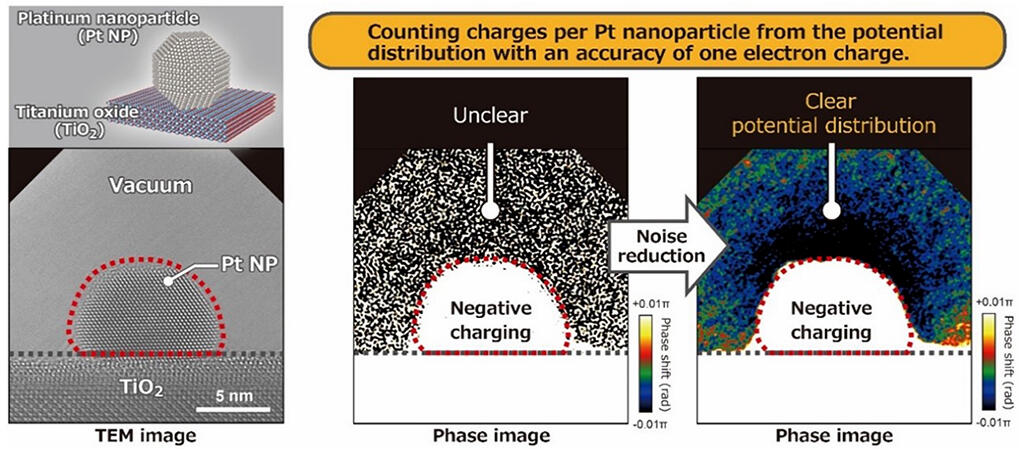Achievement will accelerate development of catalysts to solve global environmental problems.
A joint research team of Kyushu University, Hitachi, Ltd., the National Institute of Technology (KOSEN) Akashi College, and Osaka University has developed a new electron microscopy method that can measure the charge of metal nanoparticles with an accuracy of one electron charge. This was achieved by combining state-of-the-art electron microscopy technology with informatics methods to improve the accuracy of electron holography phase measurements by one order of magnitude. The team measured platinum nanoparticles supported on titanium dioxide, making them the first in the world to identify that the state of the bonding interface and the degree of lattice strain in platinum crystals caused the net charge to change, both positively and negatively. "We would like to move forward by accelerating the development of catalysts to solve global environmental problems by developing a measurement system for actual reaction environments, such as in the presence of reactive gases and in high temperature regions," explained Associate Professor Ryotaro Aso of Kyushu University. The team's results were published in Science.

Provided by Murakami Lab, Kyushu University
Since high-performance, long-life catalysts are associated with carbon neutrality and improved productivity, researchers around the world have been engaged in intense research and development efforts. Metal nanoparticle catalysts, in particular, are an important target for development because they are used in a variety of fields, including exhaust gas purification for automobiles and factories, oil refining, chemical product manufacturing, and fuel cell electrocatalysts.
Factors that affect the properties of metal nanoparticle catalysts include the type and shape of the metal nanoparticle, the type and shape of the support, and the charge transfer between the metal nanoparticles and the support. Among these, understanding the charge states that contribute to catalytic reactions is an essential element for developing high-performance catalysts.
For example, determining the potential distribution of Pt nanoparticles supported on titanium dioxide would help improve the understanding of the elementary processes of chemical reactions on the surface of the catalyst. However, the small change in charge makes actual measurement difficult, and there have been different reports on even the most basic question of whether Pt nanoparticles are positively or negatively charged.
Electron holography, a transmission electron microscopy method, can reveal the distribution of electric and magnetic fields in a local area by measuring the phase change of electron waves transmitted through a sample. However, to measure the weak potential distribution and charging of nanoparticles, the phase measurement accuracy must be increased by one order of magnitude.
A joint research team made up of a group led by Associate Professor Ryotaro Aso and Professor Yasukazu Murakami of the Faculty of Engineering, Kyushu University, a group led by Senior Researcher Toshiaki Tanigaki and Technical Advisor Hiroyuki Shinada of Hitachi, Ltd., Professor Hiroshi Nakanishi of KOSEN Akashi College, specially-appointed Associate Professor Yoshihiro Midoh of the Graduate School of Information Science and Technology, Osaka University, and Professor Hisahiro Einaga and Associate Professor Hajime Hojo of the Interdisciplinary Graduate School of Engineering Sciences, Kyushu University, has achieved phase measurement accuracy that is one order of magnitude higher than that of conventional systems by developing three elemental technologies related to information science and data science.
First, they developed an automatic hologram collection technique that previously required adjustment for each image, which also made it possible to perform integrated averaging of multiple image data. This improved data collection by a factor of 100. Next, they developed an image analysis model using deep learning to automatically select the necessary images from a large amount of data. The team also developed a wavelet hidden Markov model to distinguish between noise and weak signals, enabling optimal noise reduction.
They then analyzed the net charge of platinum nanoparticles supported on titanium dioxide under the 1.2 megavolt atomic-resolution holography electron microscope at Kyushu University, which boasts the world's highest performance in the parallelism of electron waves that is closely related to the image quality of holograms.
As a result, they successfully measured with an accuracy of one electron the charge on a nanoparticle by analyzing the potential distribution in the vacuum region around the platinum nanoparticles. The nanoparticles were found to be either negatively or positively charged. Since the structure at the atomic level can also be analyzed at the same time, they could identify that the net charge changes due to crystal strain.
"When different materials come into contact with each other, the magnitude of work used to pull electrons out of the material determines where the electrons move," says Murakami. "In this case, we were able to actually measure that the way the platinum and titanium dioxide crystals were oriented changed the size of the work function, which determined the net charge and whether it was negative or positive." According to Toshiaki Tanigaki, "Currently, it takes several minutes to take an image because multiple images must be accumulated, but we would like to develop the capability to take images at the picosecond level in a few years so that we can observe the catalytic reaction itself."
This article has been translated by JST with permission from The Science News Ltd.(https://sci-news.co.jp/). Unauthorized reproduction of the article and photographs is prohibited.




